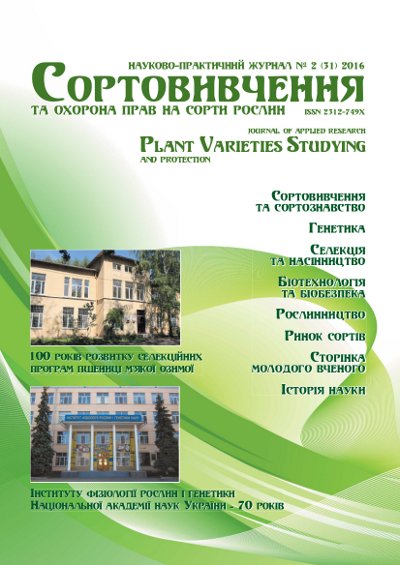Methodical aspects of assessing grape breeding material
DOI:
https://doi.org/10.21498/2518-1017.2(31).2016.70052Keywords:
grape, procedure, genotype, seedling, economic characters, adaptability, productivity, perceptivenessAbstract
Purpose. Developing methodical aspects of assessing grape breeding material in hybrid combinations for a number of indicators of adaptability and productivity. Methods. Breeding, hybridological, statistical ones. Results. Main requirements were determined for a new generation of table and technical grapes that was based on the set breeding task and patent searches, literary sources and Internet resources. 12 main indicators of adaptability, productivity and quality of products were analyzed, a high level of their display is required for pre-selection of grape seedlings for further study. Gradation from the lowest level of display of the above economic characters of grapes to the medium and high ones was developed. For their definition points-based system is used – the lowest level of display corresponds to one and three points, average – five, and high – seven and nine. As a result, studied plants can score 12 to 108 points. Variation in the plant evaluation over the years should not exceed 10 points. A seedling cannot be selected by the maximum level of displaying only one parameter, in the same manner as it shall be rejected with a minimum level of display of any of the said indicators. Seedlings that display a stable middle level of traits can be placed to the breeding nursery to study the level of display of the essential parameters and properties of the grafted culture. Conclusions. Criteria and basic parameters of genotypic values in hybrid combinations were determined. Plants that have been estimated in 60 points or higher may be considered as promising ones, that is those which require further studying. Valuable genotypes correspond to the level of 80–100, very valuable – of 101–108 points.
Downloads
References
Aleksandrov, E. G., & Gaina, B. S. (2015). Trebovaniya, predyavlyaemye k sozdaniyu novykh sortov vinograda [Requirements to the creation of new varieties of grapes]. Vinogradarstvo і vinorobstvo [Viticulture and winemaking], 52, 3–8. [in Russian]
Troshin, L. P. (1999). Ampelografiya і selekciya vinograda [Ampelography and grape breeding]. Krasnodar: Izd. tsekh “Vol’nye mastera”. [in Russian]
Vitis International Variety Catalogue (VIVC). (n.d.). Retrieved from http://www.vivc.de
Ayvazyan, P. K., & Dokuchaeva, E. N. (1960). Selektsiya vinogradnoy lozy [Grapevine breeding]. Kiev: UASKhN. [in Russian]
Lazarevskiy, M. N. (1963). Izuchenie sortov vinograda [The study of grape varieties]. Rostov-on-Don: Izd. Rostovskogo universiteta. [in Russian]
Amirdzhanov, A. G. (1992). Metody otsenki produktivnosti vinogradnikov s osnovami programmirovaniya urozhaev [Methods for assessing the productivity of vineyards with the basics of harvest programming]. Kishinev: Shtiintsa. [in Russian]
Bankovska, M. H. (2007). Otsinka stiikosti henotypiv vynohradu proty hrybnykh khvorob [Assessment of grape genotypes resistance to fungal diseases]. Vinogradarstvo і vinorobstvo [Viticulture and winemaking], 45(1), 20–25. [in Ukrainian]
Metodyka provedennia ekspertyzy sortiv vynohradu (Vitis L.) na vidminnist, odnoridnist i stabilnist [Guidelines for the conduct of tests for distinctness, uniformity and stability of Grapevine (Vitis L.)]. Retrieved from http://sops.gov.ua/uploads/files/documents/Metodiki/304.pdf. [in Ukrainian]
Downloads
Published
How to Cite
Issue
Section
License
Copyright (c) 2016 Ukrainian Institute for Plant Variety Examination

This work is licensed under a Creative Commons Attribution-ShareAlike 4.0 International License.
Starting in 2022, the copyright to the publication remains with the authors
Our journal abides by the CREATIVE COMMONS copyright rights and permissions for open access journals.
Authors, who are published in this journal, agree to the following conditions:
- The authors reserve the right to authorship of the work and pass the first publication right of this work to the journal under the terms of a Creative Commons Attribution License, which allows others to freely distribute the published research with the obligatory reference to the authors of the original work and the first publication of the work in this journal.
- The authors have the right to conclude separate supplement agreements that relate to non-exclusive work distribution in the form in which it has been published by the journal (for example, to upload the work to the online storage of the journal or publish it as part of a monograph), provided that the reference to the first publication of the work in this journal is included.

























 Ukrainian Institute for Plant Varieties Examination
Ukrainian Institute for Plant Varieties Examination  Селекційно-генетичний інститут
Селекційно-генетичний інститут Institute of Plant Physiology and Genetics of the National Academy of Sciences of Ukraine
Institute of Plant Physiology and Genetics of the National Academy of Sciences of Ukraine
 The National Academy of Agrarian Sciences of Ukraine
The National Academy of Agrarian Sciences of Ukraine